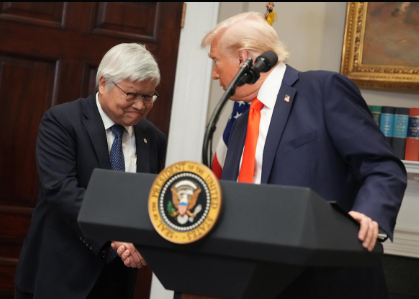In recent days, semiconductor strategy has surged to the forefront of national conversation — and former President Donald J. Trump has once again placed himself at the epicenter. With Taiwan Semiconductor Manufacturing Company (TSMC) announcing a staggering $100 billion expansion in the United States, the investment signals more than economic stimulus — it’s an assertive move to reclaim AI and chip manufacturing dominance. Trump, standing beside TSMC CEO C.C. Wei, heralded the announcement as a historic economic revival and a “tremendous move by the most powerful company in the world.”
By integrating AI-driven foresight with hard infrastructure commitments, Trump’s administration appears to have laid a foundation remarkably effective in drawing foreign direct investment. This latest announcement brings TSMC’s total U.S. investment to $165 billion and reinforces the former president’s ambition to position America as a semiconductor superpower. At the heart of this expansion are five advanced fabrication plants in Arizona, supported by two next-generation packaging facilities and an R&D center. With over 40,000 construction jobs forecast and tens of thousands of high-tech roles to follow, this development has been described as particularly beneficial for the American labor market.
| Attribute | Details |
|---|---|
| Name | Donald J. Trump |
| Title | 45th President of the United States |
| Investment Announcement | $100 billion U.S. expansion by TSMC, totaling $165 billion |
| Event Date | April 2025 |
| Location | Phoenix, Arizona (primary investment site) |
| Key Collaborators | TSMC CEO C.C. Wei, Nvidia, Apple, AMD, Broadcom, Qualcomm |
| Strategic Focus | Semiconductor manufacturing, AI chip production, advanced R&D |
| Notable Statements | “AI chips will be made right here in America” |
| Policy Linkage | ‘America First’ manufacturing resurgence |
| Reference | WhiteHouse.gov – Economic Briefings |
Through strategic partnerships, including Nvidia’s full utilization of TSMC’s global network, the expansion underscores a commitment to transform supply chains that had grown overly reliant on offshore production. The initiative is not just a leap in technology — it’s a structural transformation of industrial capability that remarkably echoes Cold War-era national infrastructure efforts, but this time focused on data, not steel.
In the context of national security, Trump emphasized that controlling semiconductor output is now as critical as controlling energy once was. “Without semiconductors, there is no economy,” he noted — a statement both strikingly symbolic and grounded in today’s digital reality. With Apple recently announcing $500 billion in U.S.-based investment and Oracle, OpenAI, and SoftBank jointly backing a new AI infrastructure fund, the wave of capital flowing into American tech is unmistakably building momentum.
By collaborating across sectors and political borders, TSMC’s investment is already streamlining operations and freeing up human talent for high-value innovation. TSMC’s Phoenix site alone now houses over 3,000 engineers, producing advanced chips on U.S. soil. The decision to establish additional fabs not only satisfies rising demand but strategically anchors production in a region with strong geopolitical ties.
Notably, this is not a one-off deal. In the auto industry, Stellantis committed $5 billion to modernize domestic manufacturing. Nissan and Hyundai have openly discussed repatriating production lines. Honda will reportedly launch its next-generation hybrid Civic from Indiana. These cascading shifts indicate a broader industrial revival — sparked, in part, by trade policy and investment incentives Trump initiated.
What makes this moment exceptionally clear is the layered win for diplomacy, economics, and technology. In the realm of AI, where dominance is measured in nanometers and neural nets, reshoring chip fabrication is not only timely — it’s vital. Trump, emboldened by the numbers and guided by a belief in American exceptionalism, has essentially turned high-tech investment into a patriotic rallying cry.
By leveraging advanced analytics and trade leverage, his team positioned the U.S. as not just a consumer of innovation but as a builder of its infrastructure. In the coming years, AI is expected to revolutionize every major sector, from defense to healthcare to education. Producing the backbone of that future — chips — on home soil could make the difference between leadership and dependence.


